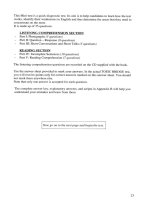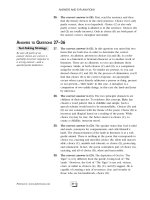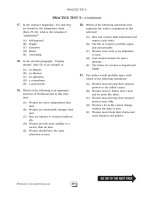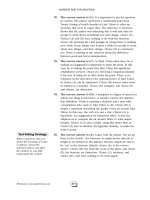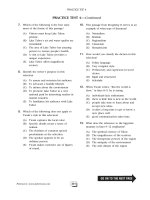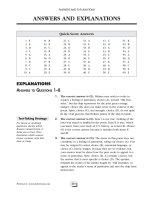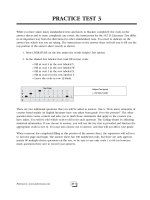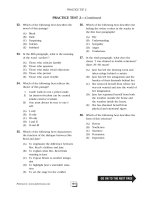SAT II success literature Episode 1 Part 2 pdf
Bạn đang xem bản rút gọn của tài liệu. Xem và tải ngay bản đầy đủ của tài liệu tại đây (120.32 KB, 20 trang )
Week 6
Lesson 1 • Take Practice Test 3 and complete the self-scoring process.
• Compare the score for Practice Test 3 to your scores on Practice
Tests 1 and 2.
• Read the “Answers and Explanations” for all the questions regard-
less of whether you got the answer correct. Which question types
continue to be a concern? Are you better able to understand what
you read? Has your pacing improved?
Lesson 2 • Depending on where you still need improvement, review Chapters
2, 3, and 4 and the table “Strategies for Answering Objective
Questions/Making Educated Guesses,” p. 60.
• Go back over the questions you answered incorrectly. See if any of
the strategies on the table would have helped you and how.
Week 7
Lesson 1 • Take Practice Test 4 and complete the self-scoring process.
• Compare the score for Practice Test 4 to your scores on Practice
Tests 2 and 3.
• Read the “Answers and Explanations” for all the questions regard-
less of whether you got the answer correct. Which question types
continue to be a concern? Are you better able to understand what
you read? Has your pacing improved?
Lesson 2 • Depending on where you still need improvement, review Chapters
2, 3, and 4 and the table “Strategies for Answering Objective
Questions/Making Educated Guesses,” p. 60.
• Go back over the questions you answered incorrectly. See if any of
the strategies on the table would have helped you and how.
RED ALERT
RED ALERT
11Peterson’s: www.petersons.com
Week 8
Lesson 1 • Take Practice Test 5 and complete the self-scoring process.
• Compare the score for Practice Test 5 to your scores on Practice
Tests 1 through 4 and the Diagnostic Test.
• Read the “Answers and Explanations” for all the questions regard-
less of whether you got the answer correct. Which question types
continue to be a concern? Are you better able to understand what
you read? Has your pacing improved?
Lesson 2 • Depending on where you still need improvement, review Chapters
2, 3, and 4 and the table “Strategies for Answering Objective
Questions/Making Educated Guesses,” p. 60.
• Go back over the questions you answered incorrectly. See if any of
the strategies on the table would have helped you and how.
Week 9
Lesson 1 • Read and analyze articles in magazines or your literature anthology
to practice your skills. Look for tone, method of organization,
characterization, unusual word use, figures of speech—those
factors that the SAT II: Literature Test assesses.
• Review Chapters 1 through 4.
Lesson 2 • Randomly choose selections from the Diagnostic Test and Practice
Tests and review the “Answer and Explanations” to remind yourself
of strategies you can use to unlock the answers.
• Reread “Scoring High on the SAT II: Literature Test,” pp. 6–8, and
“Top 10 Strategies for Acing the Test,” p. 1.
• Assemble all the materials you need on test day: pencils, a watch,
and your registration information.
RED ALERT
RED ALERT
12 Peterson’s SAT II Success: Literature
THE PANIC PLAN
Eighteen weeks, nine weeks, how about two weeks? If you are the
kind of person who puts everything off until the last possible minute,
here is a two-week panic plan. Its objectives are to make you familiar
with the test format and directions and to help you get as many right
answers as possible.
Week 1
• Read “Top 10 Strategies for Acing the Test,” p. 1, and “Scoring
High on the SAT II: Literature Test,” pp. 6–8.
• Take the Diagnostic Test. Read the directions carefully and use a
timer.
• Complete the self-scoring process.
• Read the “Answers and Explanations.” You can learn a lot about
the types of questions in the multiple-choice section by working
through the answers.
• Read Chapter 1, Elements of Prose, paying particular attention to
the types of questions that you had difficulty with on the Diagnos-
tic Test.
• Read Chapter 2, Elements of Poetry, paying particular attention to
the types of questions that you had difficulty with on the Diagnos-
tic Test.
• Review Chapter 4, A Quick Review of Literary Terms.
• Take Practice Test 1.
• Complete the self-scoring process, and see where you may still
have problems with question types. Reread Chapter 2 and com-
plete the set of practice questions.
• Read all the answer explanations, including those you identified
correctly.
RED ALERT
RED ALERT
13Peterson’s: www.petersons.com
Week 2
• Reread “Top 10 Strategies for Acing the Test,” p. 1, and “Scoring
High on the SAT II: Literature Test,” pp. 6–8.
• Complete Practice Test 2 and score it. Read all the answer explana-
tions, including those you identified correctly. Where are you still
having problems with comprehension? With which question types?
How many questions were you able to answer?
• Review Chapters 2 and 3 and the table “Strategies for Answering
Objective Questions/Making Educated Guesses,” p. 60.
• Complete Practice Test 3 and score it. Read all the answer explana-
tions, including those you identified correctly. Where are you still
having problems with comprehension? With which question types?
How many questions were you able to answer?
• If possible, complete Practice Test 4 and score it. Read all the
answer explanations, including those you identified correctly.
Where are you still having problems with comprehension? With
which question types? How many questions were you able to
answer?
• Review applicable sections of Chapters 2 and 3 and the table
“Strategies for Answering Objective Questions/Making Educated
Guesses,” p. 60.
• If possible, complete Practice Test 5 and score it. Read all the
answer explanations, including those you identified correctly.
Where are you still having problems with comprehension? With
which question types? How many questions were you able to
answer?
RED ALERT
RED ALERT
14 Peterson’s SAT II Success: Literature
WHY TAKE THE DIAGNOSTIC TEST?
What do you know about the format and questions on the SAT II:
Literature Test? If you knew all you needed to know, you probably
would not be reading this book. Taking a practice test is one way to
learn about the test and what it will be like taking it on the real test
day. You will need to pace yourself so you can answer as many
questions as possible in the 60 minutes. Taking the Diagnostic Test
will help you learn how much time you can spend on each item.
Practice may not make perfect, but you can improve your score
with practice. The more you learn about your strengths and weak-
nesses in test-taking abilities and in analytical skills, and the more you
work on strengthening them, the better your score.
How should you take this test? Just as though it were the real
test, so that means setting aside 60 minutes of uninterrupted, quiet
time to take the test, plus the time to score your answers.
• Make a photocopy of an answer sheet at the back of this
book.
• Assemble four number 2 pencils and the answer sheet.
• Use a timer or a stopwatch to time yourself.
• When you have completed the test, check how many ques-
tions you were able to answer. This information will help you
in pacing yourself for the other practice tests and for the real
test.
• Then check the multiple-choice questions against the “Quick-
Score Answers,” page 37.
• Read the explanation for each answer, even if your answer
was correct. You might learn something you didn’t know
about the content of the question.
• Turn to the Practice Plan and design your study plan from
now until test day.
RED ALERT
RED ALERT
15Peterson’s: www.petersons.com
Diagnostic Test
ANSWER SHEET
Leave any unused
answer spaces blank.
Test Code
V
ÞO
1
ÞO
2
ÞO
3
ÞO
4
ÞO
5
ÞO
6
ÞO
7
ÞO
8
ÞO
9
W ÞO
1
ÞO
2
ÞO
3
ÞO
4
ÞO
5
ÞO
6
ÞO
7
ÞO
8
ÞO
9
X ÞO
1
ÞO
2
ÞO
3
ÞO
4
ÞO
5
Y ÞO
A
ÞO
B
ÞO
C
ÞO
D
ÞO
E
Q ÞO
1
ÞO
2
ÞO
3
ÞO
4
ÞO
5
ÞO
6
ÞO
7
ÞO
8
ÞO
9
Subject Test (print)
FOR ETS
USE ONLY
R/C W/S1 FS/S2 CS/S3 WS
1 O
A
O
B
O
C
O
D
O
E
2 O
A
O
B
O
C
O
D
O
E
3 O
A
O
B
O
C
O
D
O
E
4 O
A
O
B
O
C
O
D
O
E
5 O
A
O
B
O
C
O
D
O
E
6 O
A
O
B
O
C
O
D
O
E
7 O
A
O
B
O
C
O
D
O
E
8 O
A
O
B
O
C
O
D
O
E
9 O
A
O
B
O
C
O
D
O
E
10 O
A
O
B
O
C
O
D
O
E
11 O
A
O
B
O
C
O
D
O
E
12 O
A
O
B
O
C
O
D
O
E
13 O
A
O
B
O
C
O
D
O
E
14 O
A
O
B
O
C
O
D
O
E
15 O
A
O
B
O
C
O
D
O
E
16 O
A
O
B
O
C
O
D
O
E
17 O
A
O
B
O
C
O
D
O
E
18 O
A
O
B
O
C
O
D
O
E
19 O
A
O
B
O
C
O
D
O
E
20 O
A
O
B
O
C
O
D
O
E
21 O
A
O
B
O
C
O
D
O
E
22 O
A
O
B
O
C
O
D
O
E
23 O
A
O
B
O
C
O
D
O
E
24 O
A
O
B
O
C
O
D
O
E
25 O
A
O
B
O
C
O
D
O
E
26 O
A
O
B
O
C
O
D
O
E
27 O
A
O
B
O
C
O
D
O
E
28 O
A
O
B
O
C
O
D
O
E
29 O
A
O
B
O
C
O
D
O
E
30 O
A
O
B
O
C
O
D
O
E
31 O
A
O
B
O
C
O
D
O
E
32 O
A
O
B
O
C
O
D
O
E
33 O
A
O
B
O
C
O
D
O
E
34 O
A
O
B
O
C
O
D
O
E
35 O
A
O
B
O
C
O
D
O
E
36 O
A
O
B
O
C
O
D
O
E
37 O
A
O
B
O
C
O
D
O
E
38 O
A
O
B
O
C
O
D
O
E
39 O
A
O
B
O
C
O
D
O
E
40 O
A
O
B
O
C
O
D
O
E
41 O
A
O
B
O
C
O
D
O
E
42 O
A
O
B
O
C
O
D
O
E
43 O
A
O
B
O
C
O
D
O
E
44 O
A
O
B
O
C
O
D
O
E
45 O
A
O
B
O
C
O
D
O
E
46 O
A
O
B
O
C
O
D
O
E
47 O
A
O
B
O
C
O
D
O
E
48 O
A
O
B
O
C
O
D
O
E
49 O
A
O
B
O
C
O
D
O
E
50 O
A
O
B
O
C
O
D
O
E
51 O
A
O
B
O
C
O
D
O
E
52 O
A
O
B
O
C
O
D
O
E
53 O
A
O
B
O
C
O
D
O
E
54 O
A
O
B
O
C
O
D
O
E
55 O
A
O
B
O
C
O
D
O
E
56 O
A
O
B
O
C
O
D
O
E
57 O
A
O
B
O
C
O
D
O
E
58 O
A
O
B
O
C
O
D
O
E
59 O
A
O
B
O
C
O
D
O
E
60 O
A
O
B
O
C
O
D
O
E
61 O
A
O
B
O
C
O
D
O
E
62 O
A
O
B
O
C
O
D
O
E
63 O
A
O
B
O
C
O
D
O
E
64 O
A
O
B
O
C
O
D
O
E
65 O
A
O
B
O
C
O
D
O
E
66 O
A
O
B
O
C
O
D
O
E
67 O
A
O
B
O
C
O
D
O
E
68 O
A
O
B
O
C
O
D
O
E
69 O
A
O
B
O
C
O
D
O
E
70 O
A
O
B
O
C
O
D
O
E
71 O
A
O
B
O
C
O
D
O
E
72 O
A
O
B
O
C
O
D
O
E
73 O
A
O
B
O
C
O
D
O
E
74 O
A
O
B
O
C
O
D
O
E
75 O
A
O
B
O
C
O
D
O
E
76 O
A
O
B
O
C
O
D
O
E
77 O
A
O
B
O
C
O
D
O
E
78 O
A
O
B
O
C
O
D
O
E
79 O
A
O
B
O
C
O
D
O
E
80 O
A
O
B
O
C
O
D
O
E
81 O
A
O
B
O
C
O
D
O
E
82 O
A
O
B
O
C
O
D
O
E
83 O
A
O
B
O
C
O
D
O
E
84 O
A
O
B
O
C
O
D
O
E
85 O
A
O
B
O
C
O
D
O
E
86 O
A
O
B
O
C
O
D
O
E
87 O
A
O
B
O
C
O
D
O
E
88 O
A
O
B
O
C
O
D
O
E
89 O
A
O
B
O
C
O
D
O
E
90 O
A
O
B
O
C
O
D
O
E
91 O
A
O
B
O
C
O
D
O
E
92 O
A
O
B
O
C
O
D
O
E
93 O
A
O
B
O
C
O
D
O
E
94 O
A
O
B
O
C
O
D
O
E
95 O
A
O
B
O
C
O
D
O
E
96 O
A
O
B
O
C
O
D
O
E
97 O
A
O
B
O
C
O
D
O
E
98 O
A
O
B
O
C
O
D
O
E
99 O
A
O
B
O
C
O
D
O
E
100 O
A
O
B
O
C
O
D
O
E
18 Peterson’s SAT II Success: Literature
DIAGNOSTIC TEST
While you have taken many standardized tests and know to blacken completely the ovals on the
answer sheets and to erase completely any errors, the instructions for the SAT II: Literature Test differ
in an important way from the directions for other standardized tests. You need to indicate on the
answer key which test you are taking. The instructions on the answer sheet will tell you to fill out the
top portion of the answer sheet exactly as shown.
1. Print LITERATURE on the line under the words Subject Test (print).
2. In the shaded box labeled Test Code fill in four ovals:
—Fill in oval 3 in the row labeled V.
—Fill in oval 1 in the row labeled W.
—Fill in oval 1 in the row labeled X.
—Fill in oval D in the row labeled Y.
—Leave the ovals in row Q blank.
Test Code
V
ÞO
1
ÞO
2
Þ ÞO
4
ÞO
5
ÞO
6
ÞO
7
ÞO
8
ÞO
9
W Þ ÞO
2
ÞO
3
ÞO
4
ÞO
5
ÞO
6
ÞO
7
ÞO
8
ÞO
9
X Þ ÞO
2
ÞO
3
ÞO
4
ÞO
5
Y ÞO
A
ÞO
B
ÞO
C
Þ ÞO
E
Q ÞO
1
ÞO
2
ÞO
3
ÞO
4
ÞO
5
ÞO
6
ÞO
7
ÞO
8
ÞO
9
Subject Test (print)
LITERATURE
There are two additional questions that you will be asked to answer. One is “How many semesters of
courses based mainly on English literature have you taken from grade 10 to the present?” The other
question lists course content and asks you to mark those statements that apply to the courses you
have taken. You will be told which ovals to fill in for each question. The College Board is collecting
statistical information. If you choose to answer, you will use the key that is provided and blacken the
appropriate ovals in row Q. You may also choose not to answer, and that will not affect your grade.
When everyone has completed filling in this portion of the answer sheet, the supervisor will tell you
to turn the page and begin. The answer sheet has 100 numbered ovals, but there are only approxi-
mately 60 multiple-choice questions on the test, so be sure to use only ovals 1 to 60 (or however
many questions there are) to record your answers.
19Peterson’s: www.petersons.com
Directions: This test consists of selections of literature and
questions on their content, style, and form. After you have read
each passage, choose the answer that best answers the question
and fill in the appropriate oval on the answer sheet.
Note: Read each question carefully, paying particular attention
to those that contain the words not, least, or except.
Questions 1–10. Read the poem carefully and then choose the
answers to the questions.
My Heart’s in the Highlands
Line My heart’s in the Highlands, my heart is not here,
My heart’s in the Highlands a-chasing the deer,
A-chasing the wild deer and following the roe–
My heart’s in the Highlands, wherever I go!
Farewell to the Highlands, farewell to the North,
The birthplace of valor, the country of worth!
Wherever I wander, wherever I rove,
The hills of the Highlands forever I love.
Farewell to the mountains high cover’d with snow,
Farewell to the straths* and green valleys below,
Farewell to the forests and wild-hanging woods,
Farewell to the torrents and loud-pouring floods!
My heart’s in the Highlands, my heart is not here,
My heart’s in the Highlands a-chasing the deer,
A-chasing the wild deer and following the roe–
My heart’s in the Highlands, wherever I go!
—Robert Burns
* Wide river valleys.
SAT II SUCCESS: LITERATURE
DIAGNOSTIC TEST—Continued
5
10
15
20 Peterson’s SAT II Success: Literature
1. Which of the following devices is most
evident in this poem?
(A) Repetition
(B) Cacophony
(C) Alliteration
(D) Assonance
(E) Euphony
2. This poem is a good example of which of
the following genres?
(A) Sonnet
(B) Lyric
(C) Elegy
(D) Ode
(E) Narrative
3. Which of the following best describes the
tone of this poem?
(A) Mournful
(B) Wistful
(C) Romantic
(D) Emotional
(E) Nostalgic
4. The poet uses repetition in order to
I. add to the musicality of the poem.
II. emphasize his ideas.
III. appeal to the reader’s senses.
(A) I only
(B) II only
(C) III only
(D) I and II
(E) I and III
5. Which of the following conveys the idea
that the speaker longs for the Highlands?
(A) “Farewell to the Highlands, farewell
to the North” (line 5)
(B) “The hills of the Highlands forever I
love” (line 8)
(C) “Farewell to the mountains high
cover’d with snow” (line 9)
(D) “My heart’s in the Highlands, wher-
ever I go” (line 4)
(E) “My heart’s in the Highlands,
a-chasing the deer” (line 2)
6. Which lines in the poem begin with
parallel structure?
(A) The first three lines in the first stanza
(B) The last three lines in the second
stanza
(C) All lines in the third stanza
(D) The last two lines in the fourth stanza
(E) The first two lines in each stanza
7. The author’s use of parallelism
I. reinforces the poem’s strong visual
images.
II. adds to the poem’s rhythm.
III. elicits an emotional response from
the reader.
(A) I only
(B) II only
(C) III only
(D) I and II
(E) II and III
DIAGNOSTIC TEST
DIAGNOSTIC TEST—Continued
➡
GO ON TO THE NEXT PAGE
21Peterson’s: www.petersons.com
8. All of the following are visual images
EXCEPT
(A) “the mountains high cover’d with
snow.” (line 9)
(B) “torrents and loud-pouring floods.”
(line 12)
(C) “forests and wild-hanging woods.”
(line 11)
(D) “straths and green valleys below.”
(line 10)
(E) “wild deer and theroe.” (line 15)
9. Why do you think the poet chose to repeat
“My heart’s in the Highlands” so often?
(A) To elicit a sympathetic response from
the reader
(B) To emphasize his deep love for the
place
(C) To set the tone of the poem
(D) To add to the rhythm of the poem
(E) To appeal to the reader’s senses
10. The title of the poem tells the reader that
I. the author left his sweetheart in
Scotland.
II. the Highlands are a place that is
important to him.
III. the author has a deep emotional
attachment to the Highlands.
(A) I only
(B) II only
(C) III only
(D) II and III
(E) I, II, and III
SAT II SUCCESS: LITERATURE
DIAGNOSTIC TEST—Continued
22 Peterson’s SAT II Success: Literature
Questions 11–17. Read the passage carefully and then choose the
answers to the questions.
“Address to the Graduating Class”
University High School
Oxford, Mississippi, May 28, 1951
Line Years ago, before any of you were born, a wise Frenchman said, “If
youth knew; if age could.” We all know what he meant: that when
you are young, you have the power to do anything, but you don’t
know what to do. Then, when you have got old and experience and
observation have taught you answers, you are tired, frightened; you
don’t care, you want to be left alone as long as you yourself are safe;
you no longer have the capacity or the will to grieve over any wrongs
but your own.
So you young men and women in this room tonight, and in
thousands of other rooms like this one about the earth today, have
the power to change the world, rid it forever of war and injustice
and suffering, provided you know how, know what to do. And so
according to the old Frenchman, since you can’t know what to do
because you are young, then anyone standing here with a head full of
white hair, should be able to tell you.
But maybe this one is not as old and wise as his white hairs
pretend or claim. Because he can’t give you a glib answer or pattern
either. But he can tell you this, because he believes this. What
threatens us today is fear. Not the atom bomb, nor even fear of it,
because if the bomb fell on Oxford tonight, all it could do would be
to kill us, which is nothing, since in doing that, it will have robbed
itself of its only power over us: which is fear of it, the being afraid of
it. Our danger is not that. Our danger is the forces in the world today
which are trying to use man’s fear to rob him of his individuality, his
soul, trying to reduce him to an unthinking mass by fear and brib-
ery—giving him free food which he has not earned, easy and value-
less money which he has not worked for; the economies or ideolo-
gies or political systems, communist or socialist or democratic,
whatever they wish to call themselves, the tyrants and the politicians,
American or European or Asiatic, whatever they call themselves, who
would reduce man to one obedient mass for their own aggrandize-
ment and power, or because they themselves are baffled and afraid,
afraid of, or incapable of, believing in man’s capacity for courage and
endurance and sacrifice.
DIAGNOSTIC TEST
DIAGNOSTIC TEST—Continued
5
10
15
20
25
30
➡
GO ON TO THE NEXT PAGE
23Peterson’s: www.petersons.com
That is what we must resist, if we are to change the world for
man’s peace and security. It is not men in the mass who can and will
save Man. It is Man himself, created in the image of God so that he
shall have the power and the will to choose right from wrong, and so
be able to save himself because he is worth saving;—Man, the
individual, men and women, who will refuse always to be tricked or
frightened or bribed into surrendering, not just the right but the duty
too, to choose between justice and injustice, courage and cowardice,
sacrifice and greed, pity and self;—who will believe always not only
in the right of man to be free of injustice and rapacity and deception,
but the duty and responsibility of man to see that justice and truth
and pity and compassion are done.
So, never be afraid. Never be afraid to raise your voice for
honesty and truth and compassion, against injustice and lying and
greed. If you, not just you in this room tonight, but in all the thou-
sands of other rooms like this one about the world today and
tomorrow and next week, will do this, not as a class or classes, but as
individuals, men and women, you will change the earth; in one
generation all the Napoleons and Hitlers and Caesars and Mussolinis
and Stalins and all the other tyrants who want power and aggrandize-
ment, and the simple politicians and time-servers who themselves are
merely baffled or ignorant or afraid, who have used, or are using, or
hope to use, man’s fear and greed for man’s enslavement, will have
vanished from the face of it.
—William Faulkner
11. Which of the following best describes the
mode of this selection?
(A) Description
(B) Persuasion
(C) Narrative
(D) Exposition
(E) Argument
12. All of the following statements are themes
in this selection EXCEPT
(A) joining with like-minded people will
give us the power to end war.
(B) youth must choose honesty, truth,
and compassion.
(C) if individuals choose right action,
tyranny can be conquered.
(D) youth have the power to rid the
world of war and injustice.
(E) youth must stand for good and stand
against evil in the world.
SAT II SUCCESS: LITERATURE
DIAGNOSTIC TEST—Continued
35
40
45
50
55
24 Peterson’s SAT II Success: Literature
13. What does the speaker believe was the real
threat to people at that time?
(A) Power-mongering tyrants
(B) Ignorant, fearful politicians
(C) Man’s fear and the manipulation of
fear
(D) The potential use of the atomic bomb
(E) People who do not stand against
injustice
14. Which of the following best describes the
tone of this selection?
(A) Serious, academic
(B) Thought-provoking, illuminating
(C) Dramatic, portentous
(D) Ministerial, moralistic
(E) Passionate, motivational
15. In line 26, the phrase beginning “giving
him free food” is a good example of
(A) repetition.
(B) parallelism.
(C) redundancy.
(D) hyperbole.
(E) exemplum.
16. What effect does Faulkner’s point of view
have on his audience?
I. Use of first person adds intimacy to
the presentation
II. Use of second person enhances
audience involvement
III. Use of first person makes the speech
real for the graduates
(A) I only
(B) II only
(C) III only
(D) I and II
(E) I and III
17. What is the purpose of the parallel
construction in the sentence beginning
“Man, the individual, men and women ”
(lines 39–46)?
(A) Emphasize the contrasts
(B) Create a lyrical tone
(C) Downplay the strident quality of the
selection
(D) Reinforce Faulkner’s style
(E) Add a musical quality
DIAGNOSTIC TEST
DIAGNOSTIC TEST—Continued
➡
GO ON TO THE NEXT PAGE
25Peterson’s: www.petersons.com
Questions 18–27. Read the poem carefully and then choose the
answers to the questions.
The Splendor Falls
Line The splendor falls on castle walls
And snowy summits old in story:
The long light shakes across the lakes,
And the wild cataract leaps in glory.
Blow, bugle, blow, set the wild echoes flying,
Blow, bugle; answer, echoes, dying, dying, dying.
O hark, O hear! how thin and clear,
And thinner, clearer, farther going!
O sweet and far from cliff and scar
The horns of Elfland faintly blowing!
Blow, let us hear the purple glens replying:
Blow, bugle; answer, echoes, dying, dying, dying.
O love, they die in yon rich sky,
They faint on hill or field or river:
Our echoes roll from soul to soul,
And grow for ever and for ever.
Blow, bugle, blow, set the wild echoes flying,
And answer, echoes, answer, dying, dying, dying.
—Alfred Lord Tennyson
18. This poem is constructed around
I. love for a place, an experience.
II. the sound of the boatmen’s bugles.
III. love for the beloved.
(A) I only
(B) II only
(C) III only
(D) I and II
(E) I, II, and III
19. All of the following devices are found in
this poem EXCEPT
(A) alliteration.
(B) assonance.
(C) internal rhyme.
(D) repetition.
(E) onomatopoeia.
SAT II SUCCESS: LITERATURE
DIAGNOSTIC TEST—Continued
5
10
15
26 Peterson’s SAT II Success: Literature
20. Why do you think the author repeats the
word “dying”?
(A) To emphasize the main idea
(B) To create an echoic effect
(C) To add to the rhythm of the poem
(D) To elicit an emotional response from
the reader
(E) To involve the reader’s senses
21. In the first stanza, the author uses words
and images to
I. create the setting for the poem.
II. establish the tone of the poem.
III. present the poem’s primary meta-
phors.
(A) I only
(B) II only
(C) III only
(D) I and II
(E) I, II, and III
22. This poem is a good example of a (an)
(A) ode.
(B) lyric.
(C) elegy.
(D) narrative.
(E) sonnet.
23. In the context of this poem, what is the
meaning of the word “cataracts” in the first
stanza?
(A) The opaque lens of the eye
(B) A rabbit
(C) A waterfall
(D) A gazelle
(E) A frog
24. What do you think the author means when
he says “The horns of Elfland faintly
blowing” (line 10)?
I. The sound is coming from Elfland
(Fairyland).
II. The sound is so sweet and mystical
that it might be fairies playing.
III. He is simply paying homage to the
Irish people’s love for the wee ones.
(A) I only
(B) II only
(C) III only
(D) I and II
(E) II and III
25. In the third stanza, to what does the
author compare the dying echoes?
(A) To snowflakes falling
(B) To the sound of bugles
(C) To soulful exchange with his beloved
(D) To the wild echoes flying
(E) To his love for his beloved
26. The writer uses the phrase “the splendor
falls” (line 1) to describe the
(A) sound of the bugles blowing.
(B) love for his beloved.
(C) magnificence covering the scene.
(D) sky darkening as daylight ebbs.
(E) Earth in repose.
27. What is the mood of the poem?
(A) Thoughtful, dark, and despondent
(B) Magical and melancholy
(C) Inspirational and romantic
(D) Rational and provocative
(E) Fantastical and amusing
DIAGNOSTIC TEST
DIAGNOSTIC TEST—Continued
➡
GO ON TO THE NEXT PAGE
27Peterson’s: www.petersons.com
Questions 28–37. Read the passage carefully and then choose the
answers to the questions.
From Civil Disobedience
Line I heartily accept the motto, “That government is best which governs
least”; and I should like to see it acted up to more rapidly and
systematically. Carried out, it finally amounts to this, which also I
believe: “That government is best which governs not at all”; and
when men are prepared for it, that will be the kind of government
which they will have. Government is at best but an expedient; but
most governments are usually, and all governments are sometimes,
inexpedient. The objections which have been brought against a
standing army, and they are many and weighty, and deserve to
prevail, may also at last be brought against a standing government.
The standing army is only an arm of the standing government. The
government itself, which is only the mode which the people have
chosen to execute their will, is equally liable to be abused and
perverted before the people can act through it. Witness the present
Mexican war, the work of comparatively a few individuals using the
standing government as their tool; for in the outset, the people would
not have consented to this measure.
This American government—what is it but a tradition, though a
recent one, endeavoring to transmit itself unimpaired to posterity, but
each instant losing some of its integrity? It has not the vitality and
force of a single living man; for a single man can bend it to his will. It
is a sort of wooden gun to the people themselves; and, if ever they
should use it in earnest as a real one against each other, it will surely
split. But it is not the less necessary for this; for the people must have
some complicated machinery or other, and hear its din, to satisfy that
idea of government which they have. Governments show thus how
successfully men can be imposed on, even impose on themselves, for
their own advantage. It is excellent, we must all allow; yet this
government never of itself furthered any enterprise, but by the
alacrity with which it got out of its way. It does not keep the country
free. It does not settle the West. It does not educate. The character
inherent in the American people has done all that has been accom-
plished; and it would have done somewhat more, if the government
had not sometimes got in its way. For government is an expedient by
which men would fain succeed in letting one another alone; and, as
has been said, when it is most expedient, the governed are most let
alone by it. Trade and commerce, if they were not made of India
rubber, would never manage to bounce over the obstacles which
SAT II SUCCESS: LITERATURE
DIAGNOSTIC TEST—Continued
5
10
15
20
25
30
35
28 Peterson’s SAT II Success: Literature
legislators are continually putting in their way; and, if one were to
judge these men wholly by the effects of their actions, and not partly
by their intentions, they would deserve to be classed and punished
with those mischievous persons who put obstructions on the
railroads.
But, to speak practically and as a citizen, unlike those who call
themselves no-government men, I ask for, not at once no govern-
ment, but at once a better government. Let every man make known
what kind of government would command his respect, and that will
be one step toward obtaining it
—Henry David Thoreau
28. This passage is an example of which of the
following kinds of prose?
(A) Fiction
(B) Persuasion
(C) Exposition
(D) Description
(E) Narrative
29. How does the writer use diction to further
his purpose?
I. He uses erudite diction to appeal to
the elite.
II. He uses first-person plural pronouns
to establish an “us-against-them”
conflict.
III. He refers to government as “it” to
depersonalize it.
(A) I only
(B) II only
(C) III only
(D) II and III
(E) I, II, and III
30. Which of the following best explains
Thoreau’s ideas about government?
(A) No government at all is best.
(B) Some government is necessary, but
the less, the better.
(C) Government should get out of the
way of progress.
(D) Government should facilitate trade
and commerce.
(E) A strong government would com-
mand more respect.
31. What example does Thoreau give of
governmental abuse of power in his day?
(A) Conscription of men for the Army
(B) Obstruction of trade and commerce
(C) Legislators who promote their
self-interest
(D) Formation of a standing army
(E) Opposition to the Mexican War
DIAGNOSTIC TEST
DIAGNOSTIC TEST—Continued
40
45
➡
GO ON TO THE NEXT PAGE
29Peterson’s: www.petersons.com
32. All of the following are images Thoreau
uses to describe the government in this
passage EXCEPT
(A) “sort of wooden gun.” (line 22)
(B) “an arm of the standing government.”
(line 11)
(C) “made of India rubber.” (lines 37–38)
(D) “some complicated machinery or
other.” (line 25)
(E) “their tool.” (line 16)
33. What does Thoreau consider to be the
greatest failure of government in his time?
(A) Its failure to educate the people
(B) Its failure to support American trade
(C) Its failure to abolish slavery
(D) Its failure to heed the will of the
majority
(E) Its failure to punish bad legislators
34. What is the meaning of the word “expedi-
ent” in the sentence beginning “Govern-
ment is at best ”(line 6)?
(A) A facilitator of progress
(B) An enforcer of the popular mandate
(C) A way to get things done
(D) An agency designed for a particular
purpose only
(E) A champion of the people’s will
35. Which of the following best describes the
tone of this passage?
(A) Didactic, moralistic
(B) Sincere, persuasive
(C) Serious, grave
(D) Light, facetious
(E) Reproachful, punitive
36. By statement or implication, Thoreau urged
people to do all of the following EXCEPT
(A) tell government what kind of govern-
ment they want.
(B) allow government intervention if it
benefits you.
(C) disobey government policies with
which they disagree.
(D) make known their objections to
government policies or actions.
(E) resist government interference in
your life.
37. Although this is an excerpt, and not the
full text, it appears that Thoreau employed
which of the following methods of
organization?
(A) Sentence structure and sentence
length signal importance.
(B) Repetition of sentences provides
emphasis.
(C) Paragraphs are positioned in order of
importance.
(D) The strongest arguments are devel-
oped by contrast.
(E) Ideas are presented chronologically.
SAT II SUCCESS: LITERATURE
DIAGNOSTIC TEST—Continued
30 Peterson’s SAT II Success: Literature


